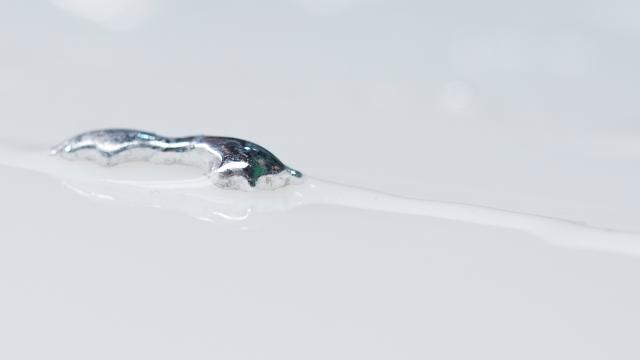Researchers from RMIT University have discovered a simple technique to make atomically thin flakes of material. The breakthrough, published in Science, is expected to lead to faster, more energy efficient electronics.
Using a surprisingly simple method, metals are dissolved in liquid metal and the resulting super-thin oxide layer is peeled off.
The technique is predicted to work with about one-third of the periodic table and some of those elements create semiconducting or dielectric materials as oxide layers.
Hafnium oxide, an insulating material used in semi-conductors, with a thickness of only three atoms has been produced with this technique. That’s approximately five to ten times thinner than hafnium oxide layers produced with previous techniques.
This research was led by Professor Kourosh Kalantar-zadeh and Dr Torben Daeneke from RMIT’s School of Engineering who experimented with the technique for the last 18 months.
“Here we found an extraordinary, yet very simple method to create atomically thin flakes of materials that don’t naturally exist as layered structures.
“We use non-toxic alloys of gallium (a metal similar to aluminium) as a reaction medium to cover the surface of the liquid metal with atomically thin oxide layers of the added metal rather than the naturally occurring gallium oxide,” said Dr Torben Daeneke. “This oxide layer can then be exfoliated by simply touching the liquid metal with a smooth surface.
“Since our gallium alloy is liquid at room temperature, this process can be done safely at ambient conditions.”
It’s simple enough that you could replicate the technique in your kitchen if you were so inclined.
Professor Kourosh Kalantar-zadeh said, “Semiconducting and dielectric components are the foundation of today’s electronic and optical devices. Working with atomically thin components is expected to lead to better, more energy efficient electronics. This technological capability has never been accessible before.”
The materials produced by this technique are useful for more than just electronics. Some of the oxide layers can be used in batteries or as catalysts.
Dr Daeneke says, “The most important outcome of our work is that we introduce liquid metals as a reaction solvent which opens the door to a whole new type of chemistry.”
The research is funded by the Australian Research Council Centre for Future Low-Energy Electronics Technologies (FLEET).
DOI (Science: 10.1126/science.aao4249)
